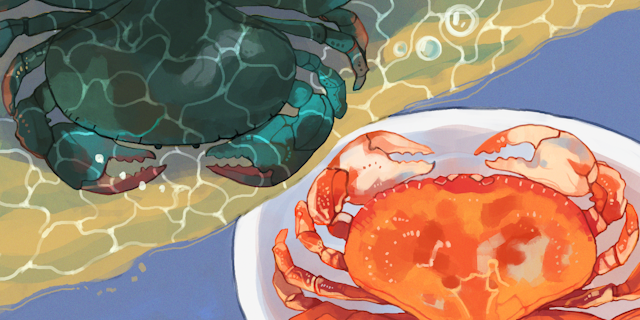This is an article from Curious Kids, a series for children. The Conversation is asking kids to send in questions they’d like an expert to answer. All questions are welcome – serious, weird or wacky!
Why do crabs and prawns shells go red after they have been cooked? – Connor, age 8, Kensington, NSW.
Crabs and prawns belong to a group of animals called crustaceans. These animals have a hard shell called an exoskeleton that is made from a similar material to human bones, but grows outside the body.
The reason for the colour change after they have been cooked is because the chemicals inside the shell react with heat.
Read more: Curious Kids: Is it true that male seahorses give birth?
In the wild, when crabs and prawns are freely moving on the ocean floor, their shells usually have a dull colour such as a brown, olive-blue, grey or a muddy colour.
The darker colour helps crustaceans avoid predators. If their bodies match their environment, it makes it harder for predators to see them. This trick likely evolved over time to help crustaceans stay safe.

A crustacean’s exoskeletons contain several chemicals called pigments, which give the crabs and prawns their colour. One of these is an orange-ey pigment called “astaxanthin”. This is a member of the family of pigments that is responsible for colouring many of the yellow, orange and red animals.
When the crustaceans are alive, the astaxanthin is tightly wrapped up and trapped by a special protein called “crustacyanin”. This is why live crabs and prawns usually look bluish-grey.
Read more: Curious Kids: What are spider webs made from and how strong are they?
Astaxanthin does not change with heat, but that protein called crustacyanin does.
Once you put a crab or a prawn in a pot of boiling water or on a grill, heat destroys the crustacyanin protein.
Then, the orange-ey astaxanthin is released, turning the shell of the crustaceans bright red. In fact, the degree of colour change tells you if the seafood is properly cooked. If it’s not red enough, it’s probably not cooked enough.

Another interesting fact is that flamingos are pink because they eat prawns. You may think that the flamingo feathers should look grey because the prawns they eat are uncooked.
The truth is that the crustacyanin protein dissolves in the acids and fats inside the flamingos’ stomach during digestion, releasing the orange-ey pigment that makes flamingo feathers more pinkish.
In fish farming, farmers feed the fish astaxanthin to make the salmon meat more reddish and the clownfish bodies more orange.
Hello, curious kids! Have you got a question you’d like an expert to answer? Ask an adult to send your question to us. They can:
* Email your question to curiouskids@theconversation.edu.au
* Tell us on Twitter

Please tell us your name, age and which city you live in. You can send an audio recording of your question too, if you want. Send as many questions as you like! We won’t be able to answer every question but we will do our best.

